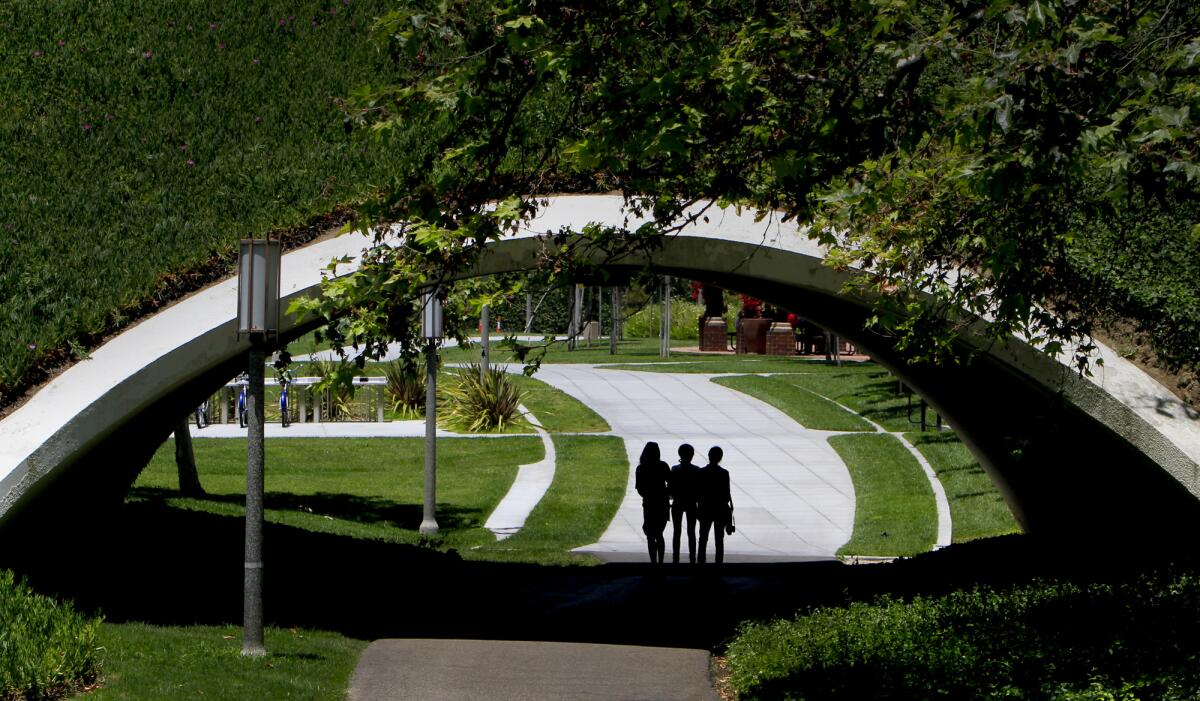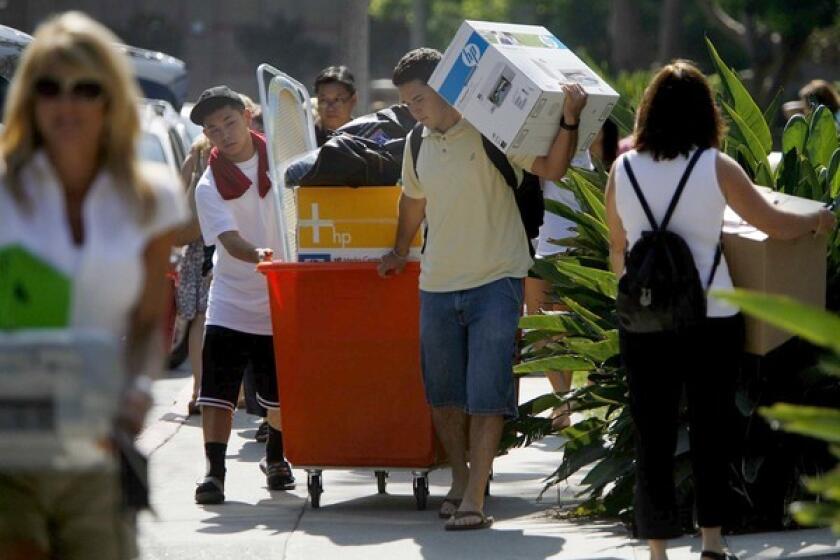Column: The UC system is one of the best and worst parts of living in California

- Share via
It is often said that California has no seasons. As any actual California resident can tell you, that is simply not true. We have loads of seasons including but not limited to: Fire season, awards season, pilot season and how-did-my-kid-and-her-4.0-not-get-into-a-UC? season.
We are currently smack dab in the middle of the last one.
Like so much in this state, the University of California system is a victim of its own popularity. Between the sunshine and the stellar academic programs, not to mention the high-voltage alumni and networking possibilities, it is among the most prestigious university systems in the world. On U.S. News and World Report’s 2020 list of U.S. colleges receiving the most applications, UCs occupied six slots, including the top five, with UCLA at No. 1. (Cal State Long Beach and San Diego State were also among the top 10.)
Any situation in which there are three times as many applicants as openings is going to lead to a lot of dashed hopes. (See also casting calls.) Acceptance rate percentages range from the mid-20s to 12% (that would be UCLA).
Combine these alarming statistics with the tax dollars every Californian pays to support the UC system and you have a brew that, like so many cocktails, can lead to euphoria and heartbreak. Mostly heartbreak, of the sort that quickly turns to wrath, especially among those many students whose GPAs, resumes and — until recently — test scores meet or exceed the historic expectations of each school.
Not to mention their parents. Who, you know, paid those taxes.
Having gone through the process fairly recently, I can tell you that the UC application process is one of the least wonderful things about living in California. For even very good students who can afford the not inconsiderable tuition, deciding which campuses to list on the UC application — each costs $70 — is less about personal preference and more about figuring out which one offers any hope of acceptance. (This requires the kind of time and energy usually reserved for mapping out a company takeover or planning a very big wedding.)
University of California admissions officers explain their decisions in a year of record applications that brought widespread heartbreak and some joy for high school seniors competing for spots.
Out of the two high-achieving children in this family who have applied for colleges thus far, only one was accepted to a single UC. Fortunately, they were both just as happy to go out of state to schools that wanted them enough to offer scholarships. (Having seen the amount of Sturm und Drang involved, the third has already announced her intention to skip the UCs entirely — we’ll see.)
The how-did-my-kid-and-her-4.0-not-get-into-UC season got so bad a few years ago that in 2018, the system put an 18% cap on out-of-state students for most of its campuses.

Alas, this did not solve the problem. This year’s applicant pool increased about 16%, putting 250,000 in contention for 46,000 spots. As so many parents of UC hopefuls learn every year — but especially this year, the worst senior year ever — the anguish of math quickly becomes the math of anguish.
And math may be the culprit for more reasons than one.
In addition to the trauma inflicted by individual rejections, early reporting on the UC situation indicates a more universally troubling underlying trend: The wildly high competition for majors in business and science. Although a desire to pursue an academic course in history, English, philosophy, gender studies or, God forbid, journalism does not in any way guarantee you a spot at the UC of your choice, it’s considerably easier to score a slot in the humanities, particularly at schools specializing in the sciences because, apparently, not as many people want to major in them.
Will society truly benefit from an entire generation forsaking the arts for the sciences?
As my colleague Teresa Watanabe recently reported, UC Irvine admission officials said more than half of this year’s applications were for just six of the school’s 85 majors. Nearly 12,000 of the 108,000 applicants wanted to major in biological sciences. Other top majors were business administration, nursing science, computer science and psychology.
And indeed, biology, managerial economics, social psychology and computer science are listed as UC Irvine’s most popular majors on the college ranking and review site Niche.com. Although UC Irvine offers many traditional humanities majors, not one of them made the top 10.
English, history and political sciences do make the top 10 at other UC campuses, including UCLA, but according to Niche.com, business/economics, biology and computer science reign supreme.
This is not surprising, considering the amount of attention and resources that have been spent in California, and indeed the rest of the country, on guiding students toward STEM (science, technology, engineering and math) programs.
It is, however, a tiny bit alarming.
In Watanabe’s recent story, admission officers warned against attempts “to game the system” by applying for, say, a history major with plans to switch to computer science. Do we really live in a world where one chooses, or is perceived to choose, a major in history only as a ruse?
Even though she really misses her college, and wants out of our house, my daughter decided the risks outweigh the benefits and is taking her classes from home.
Don’t get me wrong; no one admires mathematicians and engineers more than I, and this year has certainly proved the vital importance of science. Thank you for saving the world, all you STEM-educated vaccine inventors, developers and manufacturers.
Just as important, the increased effort to encourage groups historically excluded from STEM (girls and children of color) to develop their talents and pursue their dreams — particularly in the kinds of higher-earning professions that might mitigate other inequalities — is a wonderful thing.
But I do fear that in pushing STEM we’ve devalued the arts. Well, more than fear — I know we have. Even before the pandemic, budget cuts typically hit arts programs the hardest, especially in California; in 2016, the National Assessment of Educational Progress found that only 33% of California eighth-graders (this year’s high-school seniors) had taken a music class and only 28% had taken a visual arts class. (Both percentages were far below the national average.)
This is not great for a state that is one of the culture capitals of the world.
I’m not suggesting that students throw out their dreams of becoming molecular biologists and major in English (please, no one do this) but obviously the pendulum of social value has swung too far from areas of study in which the pendulum can be used as a highly effective metaphor to those that focus on the scientific laws that make it work.
Since I am a person who can quote examples of the former while only basically understanding the latter, I admit to a bias. Nor am I the first person to gripe about it.
People like me, i.e. people who write things about culture, have been bemoaning the decline of the humanities among college majors for decades, even as the causes of that decline — macroeconomics, a popular major — have only accelerated. But since the 2008 recession, that decline has been real and precipitous. (That same crisis resulted in school budgets being slashed, often starting with the arts — coincidence? I think not.)
On the anniversary of the birth of the Works Progress Administration, it’s worth asking what a post-COVID Federal Writers Project might look like.
It makes sense that students, and their parents, might prefer majors that seem to have a clearer — and potentially more lucrative — career path. According to several studies, including one by the Academy of Arts and Sciences, graduates, particularly women, with humanity degrees have a slightly higher rate of unemployment than those who majored in education, heath/medical sciences and life sciences. But not to the degree currently reflected in film and television, where a major in art history, French or philosophy has become a sad joke. “What was I thinking?” the attractive but beleaguered twenty-something career-seeker with an English degree sighs, staring into his or her microbrew.
Well, you were thinking about thinking, often critically. You were thinking about broadening your knowledge of the world and the forces that have helped build and improve it. Coding matters only if you have something to code, just as economics or business matters only if you have something to sell or an idea to disseminate, and someone has to come up with those things too.
If I were an aspiring entrepreneur, I might try to explore the currently underserved needs once met by all those past history, anthropology and fine arts majors. Just look at how NFTs are shaking up the art world.
Of course it would help if some attitudes changed: if degrees from certain universities weren’t considered “proof” that one job candidate was preferable to another; if the pressure to go to a “big name” college weren’t so absurdly high; if secondary schools were remotely equitable; if young people weren’t expected to map out their lives at the ripe old age of 17.
But now I’m just beyond blue-skying it. And, unfortunately, while it might help a few students, restoring a better balance between, say, religious studies majors and computer science majors is not going to solve the UC problem, which really does come down to numbers.
As the UC system clearly prides itself on its economics, math and science programs, it should be able to solve the problem itself, if only by asking some of its many award-winning alumni to put on their thinking caps.
Despite being online and off campus, students largely maintained grades and course loads, a Times survey has found, but some figures point to the continuing struggles for Black, Latino and first-generation undergrads.
As for future applicants and their parents, well, prestige and status are fueled by popularity, and the UCs are not the only game in town. The Cal State system has 23 campuses, a legion of fine programs and a host of notable alumni — NASA just named a site on Mars after science fiction legend Octavia Butler, who attended Cal State L.A.
Keep the Cals in mind — just as much sunshine and an acceptance rate of 52%.
More to Read
The biggest entertainment stories
Get our big stories about Hollywood, film, television, music, arts, culture and more right in your inbox as soon as they publish.
You may occasionally receive promotional content from the Los Angeles Times.














